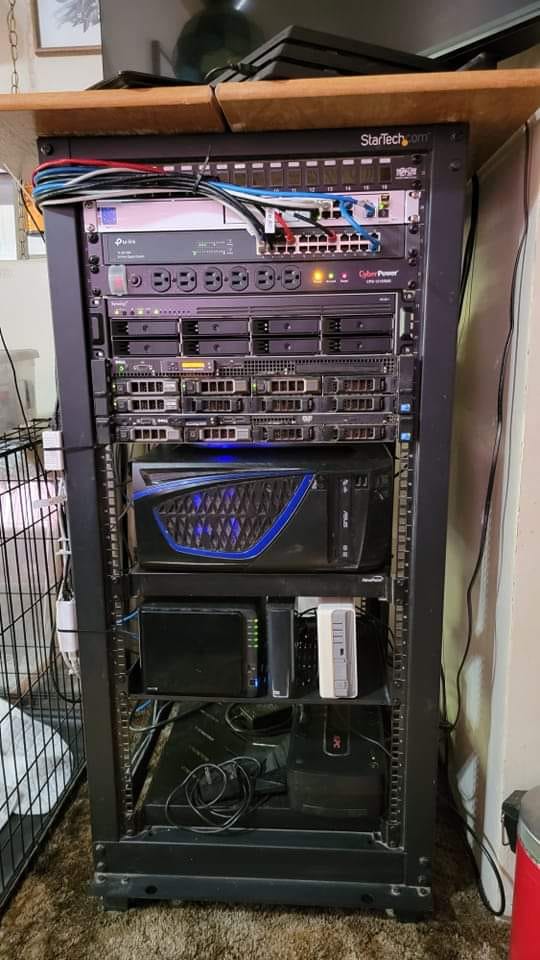My Home Lab - April 2023
This was my set up 2 years (April 2023) ago when I first got the new Synology NAS:
Previously I used Dell blade servers that I had bought used on ebay. In a rack mount they only take up a 1 or 2 inch slot. The Dell r310 was a 1 unit server that I used for my router/firewall running Untangle. The 2 unit one was a Dell r510 that ran the VMWARE esxi.
While these servers look small in the front they are actually pretty massive and heavy and need a pretty sturdy server rack to support them. In their hay day they would have been sitting in a data center running your various cloud services. Once they get old they get replaced and entire pallets full of them end up on eBay for just a little more than the cost of shipping.
These servers were about 10 years old when I got them but they were/are still very capable and about the best bang for your buck. The Dell r510 had 2 processors with 8 cores each and 192 gigs of ram. These were awesome for managing virtualization.
These were industrial servers, and these days most industrial servers run virtual machines. That means instead of running just one operating system they might run a dozen. They could have Windows 10 running along side Windows 7, and various Linux systems and what not. Each of these systems share the same server but otherwise are assigned their own portion of the resources available and act as if they were a completely separate machine. That means if one system got infected by a virus or hacked it is completely isolated from everything else as if it was on its own physical machine.
Since these servers are operated "in the cloud" they can be leased to businesses that might need a particular operating system that requires a certain level processing power, memory, and hard drive space, and rather than building them a custom PC or server they just create a virtual machine with the exact parameters they need hosted inside the larger server. Since each virtual server is isolated from each other the client can be given full access to it without any fear that they can damage or effect the other virtual machines running on the same server.
So in my case I only had about 6 or so virtual machines running on the server. I had Windows running Blue Iris which is a DVR for surveillance cameras. I had a separate Windows server running my media server and various apps, and I had a few Linux based servers running other apps and such.
I could also experiment with other operating systems and programs without fear that they could interfere with the rest that I had running.
However these servers were not really meant to run in a home environment. They are very loud. When booted up they sounded like a jet engine taking off, plus they consumed electricity like crazy and threw off a lot of heat. They were nice to learn from but have essentially been retired from use and I have since moved on to something else.
Being a fan of Synology NAS I ended up getting another one. My first was the little 1 bay white one, which I quickly out grew. I then got a 4 bay DS412 which is the black box next to it. It acted as my media server and storage for several years before I filled it up. That was when I got the Dell servers from ebay.
Now my media server runs on a new Synology, the 8 bay RS1221+ which is rack mountable because once you go rack you never go back.
The RS1221+ may be a power house for a Synology NAS but it is still a bit of a downgrade in terms of processing power and RAM compared to my 15 year old Dell servers so I had to make a few changes.
I had to move Blue Iris camera system to Beccas PC since that was not something I could run on the Synology, the rest however would work though in a slightly diminished capacity.
Technically the newer Synology does support virtualization but the memory and processor are far too limited. Even though the Synology has a modern processor it still hurt a bit going from 16 cores down to 4 cores, and from 192gb ram down to 4gb ram. So running VMs on the NAS was out of the question and that was when I decided to experiment with Docker.
Docker has a lot of the same benefits of virtual machines but is much more light weight. Each docker "container" is its own independent self contained system much like a virtual machine but it can share resources that the host has without having to duplicate them for each machine. So docker is much more efficient and doesn't require as much resources, so even on the enterprise server level Docker is replacing virtual machines for a lot of light weight applications.
So now on to my media server (which is the Synology RS1221+ NAS). I have Docker installed on it, and within Docker I have various applications each running as its own independent server. You can find out more about my media server set up under Ultimate Media Server.

